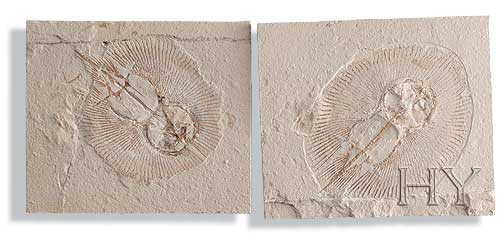The 95-million-year-old fossil stingray pictured reveals that these fish have undergone no change since they first came into being on Earth. This has gone down as yet another of the proofs demolishing the Darwinist thesis that "Fossils support the theory of evolution." Countless scientific books and articles have revealed the invalidity of these illusory evolutionist claims. The fact that fossils have failed to produce the "intermediate forms" of which Darwin dreamed—and that, on the contrary, different living groups on Earth appear suddenly in the fossil record and with all their unique structures—is agreed by a great many scientists, including many present-day evolutionist paleontologists.Niles Eldredge, for example, admits that evolutionist paleontologists are well aware of the lack of intermediate forms and the stasis in the fossil record (the fact that living species have remained unaltered), but this evidence goes ignored: "Each new generation, it seems, produces a few young paleontologists eager to document examples of evolutionary change in their fossils. The changes they have always looked for have, of course, been of the gradual progressive sort. More often than not their efforts have gone unrewarded—their fossils, rather than exhibiting the expected pattern, just seem to persist virtually unchanged. . . . This extraordinary conservatism looked, to the paleontologist keen on finding evolutionary change, as if no evolution had occurred. Thus studies documenting conservative persistence rather than gradual evolutionary change were considered failures, and, more often than not, were not even published. Most paleontologists were aware of the stability, the lack of change we call stasis." (an excerpt from Niles Eldredge, "Evolutionary Tempos and Modes: A Paleontological Perspective," in the anthology What Darwin Began: Modern Darwinian and non-Darwinian Perspectives on Evolution [ed. Godfrey, 1985], as quoted in the book Darwin on Trial by Phillip E. Johnson, Regnery Gateway, 1991, pp. 58-60) This is a mirror-image fossil, traces of which can be seen on either side of the rock surface.
TEMAS
CavourVaticanoSocialismoIluminismoRevolución FrancesaConversoSabateanoJacobinismoMedios de Comunicación MasónicosZionismo PolíticoJove TurcoComité de Unión y ProgresoAbdulhamidAntinaziOrganización Zionista MundialLas Leyes de NurembergMussoliniPrimer Guerra MundialAdolf EichmannGoyimLa Dinastía RothschildGrupos de PresiónConsejo de Relaciones ExterioresRockefellerGuerra FríaStalinRevolución de OctubreUnión SoviéticaBilderbergVietnamComité de Asuntos Públicos Estados Unidos IsraelPresiónjustoSudesteGreciaNuevo Orden MundialMar Rojogeopolíticaveteranoimpuestocostumbres2023antílopetoroConcejo Islámico de EurasiaPremio NóbelHospitalInstitución de Seguridad SocialAli BabacanTurgut OzalasesinatoGaffar OkkanMuhsin YaziciogluNebolusa RosettaAstronomíaRosaSermón de DamascoArma NuclearIyad AllawiNautilussubmarinocélula de buceoAli BardakogluTelevisiónTelevoleCanakkale


